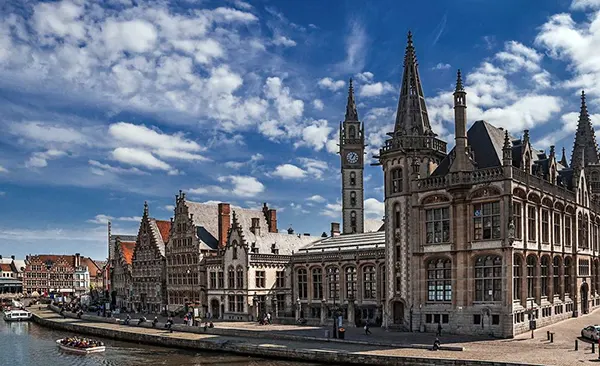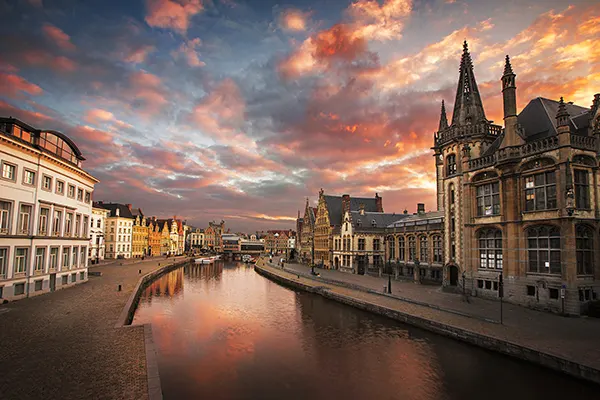Ghent — A Flemish Gem with Fewer Crowds than Bruges

Often overshadowed by the more popular Bruges, Ghent stands tall as one of Belgium’s most underrated travel destinations. With its medieval architecture, serene canals, and energetic cultural scene, Ghent offers a rich blend of history and modernity — all without the overwhelming tourist crowds. If you’re seeking an authentic Flemish experience, Ghent may just be the perfect alternative.
Why Ghent Rivals Bruges in Charm and Atmosphere
Ghent’s scenic cityscape rivals that of Bruges, boasting cobblestone streets, Gothic towers, and fairytale-like canals. Yet, unlike Bruges, it maintains a relaxed atmosphere that allows visitors to enjoy the city at their own pace. Whether you’re strolling along the Graslei or riding a bike through medieval alleys, the experience feels genuinely local.
The historical centre is impressively well-preserved, with landmarks such as St. Bavo’s Cathedral and the 91-metre tall Belfry of Ghent. These architectural treasures add depth to the city’s profile and offer stunning panoramic views over the city rooftops. The fact that you can explore them without long queues makes the visit even more rewarding.
Evenings in Ghent feel particularly magical. The city’s lighting plan subtly illuminates monuments and facades, creating a quiet, almost cinematic ambience. Instead of jostling through crowds, you’ll likely find a seat at a local bar, sipping Belgian beer as the reflections of old buildings ripple across the water.
Gravensteen Castle: A Window into Flanders’ Medieval Past
The Gravensteen Castle, or Castle of the Counts, is one of Ghent’s standout attractions. Built in the 12th century, it served as the residence of the Counts of Flanders and later as a courthouse and prison. Today, it’s a striking stone fortress that towers over the city centre and invites exploration through its well-preserved walls and towers.
Visitors can take a self-guided audio tour that cleverly blends history with humour, bringing to life tales of battles, justice, and torture. The castle houses a small museum displaying medieval weapons and armour, adding depth to the historic narrative.
Standing atop the ramparts offers an unforgettable 360-degree view of the city. You’ll spot church spires, hidden gardens, and bustling squares — a visual reminder that Ghent is both rooted in history and alive with modern vibrancy.
Where Canals and Creativity Flow Side by Side
Ghent’s canal network gives the city its tranquil rhythm, weaving through centuries-old neighbourhoods and under arched bridges. Unlike Bruges, canal cruises here are often uncrowded, allowing for a more personalised experience with local guides who share quirky facts and stories.
The Graslei and Korenlei quays are particularly picturesque, lined with step-gabled houses and lively cafes. These waterfronts serve as the city’s social hub, where students, artists, and travellers gather year-round. The energy is youthful but grounded in rich tradition, making Ghent feel both timeless and evolving.
In the Patershol district, creativity spills onto cobbled lanes, with boutique galleries, artisanal shops, and hidden bistros occupying historical buildings. This fusion of past and present is what gives Ghent its unique soul — a city that respects its roots while embracing innovation.
Street Art That Speaks Volumes
Ghent’s creative edge is perhaps best witnessed in its flourishing street art scene. The city is home to the “Sorry, Not Sorry” initiative, a project that has transformed public spaces into open-air galleries. You’ll find works from internationally acclaimed artists as well as emerging local talent, covering topics from identity to sustainability.
Werregarenstraatje, better known as Graffiti Alley, is a constantly evolving mural corridor in the city centre. It’s a legal space for expression where artists regularly paint over each other’s work, keeping the visuals fresh and surprising. It’s not just about aesthetics — the art often sparks conversations about social issues and local culture.
Guided street art walks are available, but even a spontaneous wander through the backstreets will reveal bold colours and messages tucked away on ancient brick walls. In Ghent, the past coexists with the future, and spray paint becomes a modern form of storytelling.

A City Built for Explorers, Not Tourists
One of Ghent’s biggest strengths lies in how it caters to curious visitors rather than mass tourism. It’s compact yet dense with things to see and do, and the city’s commitment to sustainability means you can explore almost everything on foot or by bike. Public transport is reliable, and electric boat tours offer an eco-friendly way to enjoy the canals.
The city also has a strong student presence, thanks to Ghent University. This academic influence contributes to the city’s dynamic cultural calendar, with festivals, talks, and exhibitions happening year-round. From jazz weekends to light shows, there’s always something unfolding in Ghent.
Finally, Ghent’s culinary scene deserves praise. From local delicacies like cuberdons (nose-shaped sweets) to Michelin-starred dining, the variety is impressive. Plus, the city is a pioneer in vegetarian-friendly cuisine, celebrating “Veggie Thursdays” long before plant-based eating became trendy.
Why Ghent Might Just Be Belgium’s Best-Kept Secret
Ghent offers everything a traveller might seek: stunning architecture, rich history, a vibrant arts scene, and mouth-watering food. Yet it does so without feeling commodified. You’re more likely to hear Flemish than English, more likely to encounter locals than tour groups — a rarity in Western European hotspots.
Its authenticity, accessibility, and cultural depth make Ghent a smart choice for travellers who want more than postcard moments. It’s a place that invites exploration, not just observation. And it rewards those who take the time to wander its streets with genuine discoveries.
In 2025, Ghent is more ready than ever to welcome mindful visitors who value culture, history, and real human connection. If you’ve been to Bruges, perhaps it’s time to meet its cooler, quieter cousin.
